Reverend Bruce Holland tribute/The Story of Bruce and Elaine
I produced this booklet for our children, grandchildren, and great-grandchildren, so they can remember us and our story (Bruce Holland).
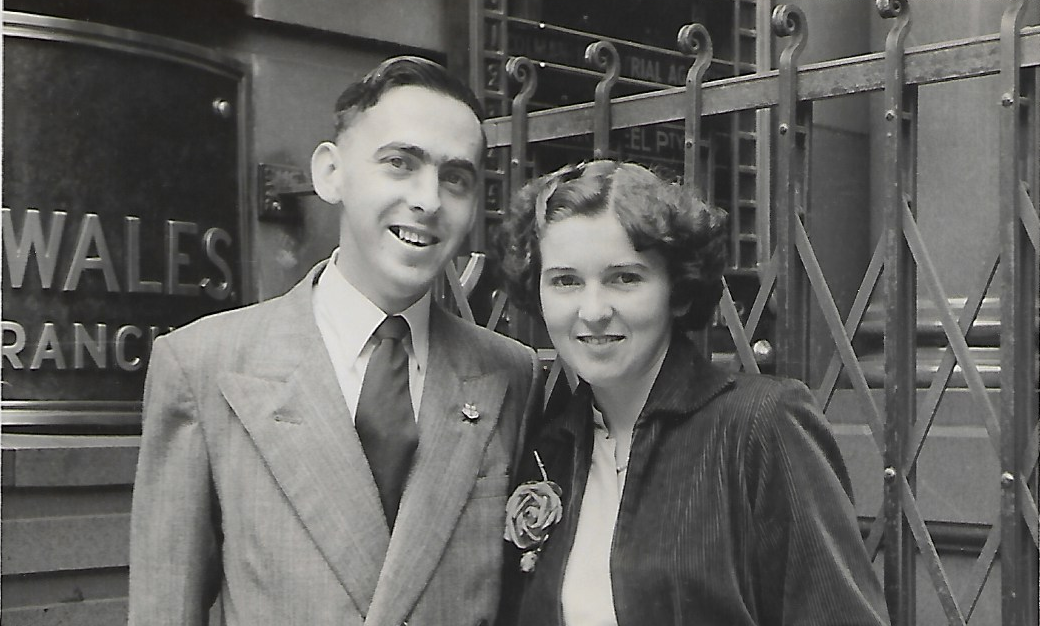
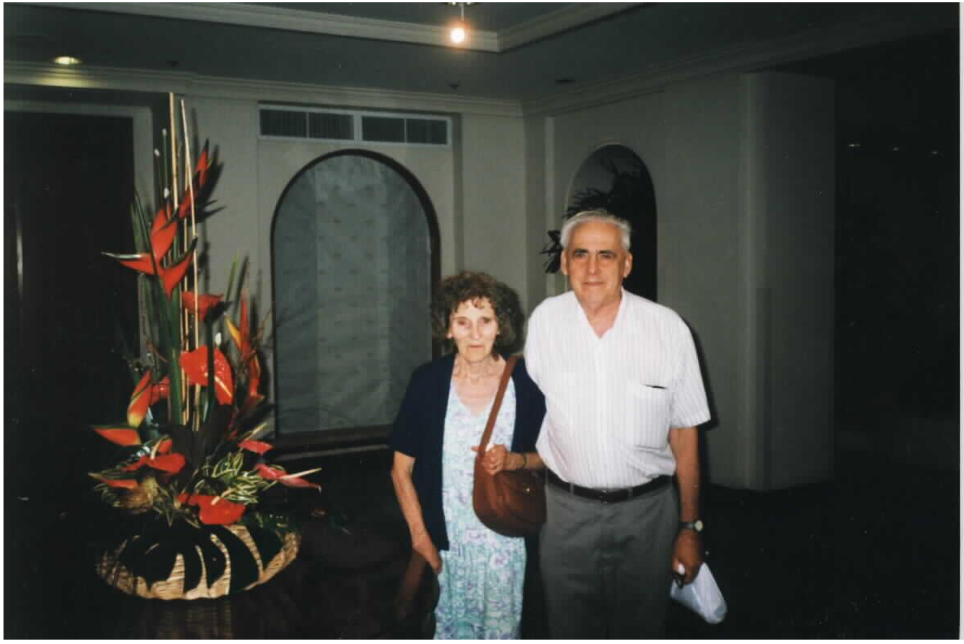
The booklet is in two sections. The first section is about my early childhood and my apprenticeship.
Section Two is about Elaine and what I know of her childhood and I conclude this section with the combined story of the both of us.
Happy reading children, I hope you enjoy it.
The Story of Bruce by Me
This section is dedicated to my mother Emelda Isobel Holland nee Heywood.
She said that I was perfect as a child.
Her exact words were, “Bruce you were perfect as a child, a perfect little nuisance”
And you know thinking back I really believe her.
...
What I remember of my childhood
My Story This booklet was written at the bidding of my brother Peter, for he said he wanted to know a lot about his early childhood. There is an age difference of three years and five months between us. There is quite amount of information that I have which Peter could have not known.
So I started out to write a little note for him, as I worked on it, I found that the writing gathered a large amount of facts and figures. We both went over the Sydney Harbour Bridge the day after the official, opening 20th March 1932 me on foot while he was pushed in stroller our mother and her sister Dorothy made up the party.
All I can remember about it was that it was a long way. We started at Wynyard station I think we went up the steps there and then walked to the Bridge approaches about half way over I start to complain about the distance “I said that I was tired and wanted to be carried” . You can guess who walked the full distance to Milsons Point station and we caught the train home.
I could not care even a little bit about the Bridge that day. Notice how prefect I was? So I start this “Tome” about me and my brother and it was only after Elaine’s death that the booklet took it present form ...
What I remember of my childhood I was born at an early age to Norman and Emelda Holland; I don’t remember the first surgery I had when I was a few weeks old. At the age of about six months I developed pneumonia in both lungs I can remember the treatment of Mustard plaster and medicines to remove phlegm, with wearing of woollen singlets etc. After Pneumonia I was left with a weak chest and often had chest infections until my teen years.
I can recall the house we lived in before we went to Queen Street I think it was at Ashbury, it had a small front yard with post and rail fencing with chain wire in the panels. Then we moved to Queen Street Croydon into a brand new house built by Uncle Harry he was a Master builder.
When I was 26 months old we all went to Wallacia camping (my father, mother and Aunty Dot and Me) in the Car -- it was a four seater Tourer, I can remember spilling my mug of milk, there was no more, so I cried, then the Kookaburras laughed at me. We also went to the river where my father took me swimming on his back, on the bank there was a device with a round manhole cover I t hought it was a fuel stove it wasn’t until years later that I realised what it really was. We lived opposite a Covent school and a Nunnery I would often go and visit the Nuns who would give me a biscuit or two and a small bottle of lemonade, I even went in to the bedroom to visit the sick nuns. I joined them in the chapel for Worship. Because we were Church of England (Anglicans) we worshiped at St Peter’s Burwood East Parish, I remembered going Church on Sunday and sitting in the front seat because my mummy and daddy sang in the Church choir. It was about this time I developed an interest in Electricity. It was at my grandparents’ home where I experimented with the power supply by placing a wire hair pin into a two pin round pin power point. I knew to not put it in until I made sure the switch was off, it was an anti-climax nothing much happened, but a small spark and then no power. The only result was I had a very sore bottom not from the power short circuit, but from the punishment I received fro m my father, I NEVER tried that again. Because it was Depression Time dad’s sister Ida came to live with us with her 2 teen aged daughters, Peggy and Kathleen, Before I turned 4 years old my brother Peter was born I was dragged from Grandma’s house at Brady Street Croydon, by my cousins to see what was at home. I was not impressed when I found that mummy now had a baby. I lost all my special importance, I now became a nothing.
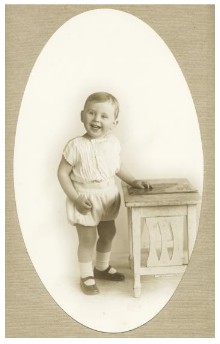
I started School at Croydon Public School in my fifth year and strangely I enjoyed the activities even with Miss Dun a cranky older woman whom we all called Miss Dunny behind her back.
When I was about 5 years old I had my Tonsils removed on the dinning room table by my Uncle Freddy who was a doctor assisted by Aunty Dot a half trained nurse, even my mum had hers removed on the same day, there were two of us with sore throats.
I can still feel the sore throat after all these years the memory will be with me until the day I die.
It was depression years and things were getting tough and to top it off my father was working as the Clerk of Works for a contractor building schools (Archie Hitchcock he had a difficult wife who made his life “hell”. ) One day he disappeared, he closed his business down and left her and all his employees, they were now out of work. Because of the Employment situation we lost the house and moved in with my grandparents for a time.
I cannot remember where this story should fit into my history, so here goes. We made many trips as a child to my Grandmother’s sister Matilda’s home at Harbord or Fresh Water as she always called it. Matilda and her husband had a dairy farm, they supplied milk to the local people, and it was there I met a number of my mother’s aunts. There was a family joke within the Heywood family as how could two sisters who were twins have one twin 20 or 30 years older than the other. Matilda’s twin sister Bella lived in Canada, -- she looked a lot younger for she knew how to apply paint -- I met her once or twice in my life, the last time was just before the war when she came back to see her sisters and family before returning home by ship. I explored that ship from top to bottom, even going into the engine room, this I did on my own, while the others said their goodbyes in Bella’s cabin.
Dad went to work for uncle Frank in his Dairy equipment factory and plans were made to build a holiday house for Uncle Frank at Mona Vale, our family moved to Mona Vale and lived in Noel Leahy’s holiday cottage (Noel was Frank’s nephew) next to the building site. We must have been there at Mona Vale for about 2 or 3 months during which time I had a holiday from school and spent most of the days on the beach or in the rock pool. It was at Mona Vale that I learnt about Brick Laying from the Brick Layer, as he laid his bricks and I wanted to help him so he showed me how to point the brick work. I spent all day working in the bathroom making a very good job for a 6 year old, can you imagine my horror when I found they had laid a concrete floor covering my handiwork.
There was also a painter named Charlie Le Page who showed me how to paint and mix colours he was very nice to me. After Mona Vale we lived at Marrickville, at Marrickville I would play under the elevated back veranda where I discovered a box of inter-stage audio transformers with terminals I soon had then “wired up” with all the spare wool I could “find” it looked great to me. You can imagine how I felt when we moved again to Dulwich Hill without my master piece for we were minding Aunt Elsie and Uncle Frank’s place while they tested the house while on holiday at Mona Vale. After that we moved again this time to Woodside Av Burwood where we lived for a number of years. After that we moved to 33 Rose Street, Enfield.
The School at Croydon Park was a great school I now had a male teacher (I was in third class) His nick name was “Blinky Bill” he had an affliction which made him blink all the time I believe he was an ex-serviceman from World War I.
We worshiped at St Nicholas Enfield in the Hall as they were building a Brick church on the land. It was there that I learnt all the hymns and canticles by heart as I was a very poor reader at the time. On Saturdays all the fathers helped in building the church and I went along and was fetch and carry for the men as I knew the names of most tools and their purpose.
At Rose Street I joined the Cub Pack at 2nd Enfield at our Church this I enjoyed and did not like it when I was told that dad was going to build a house for us at Berala.
It was at Rose Street my brother Peter, helpful as ever decided to tidy up the pantry by setting a pile of newspapers in the pantry on fire; with matches he started a roaring fire. I just happened to pass by on the way outside and noticed the fire. In the backyard we had a garden hose always connected this I turned on with water streaming out of it I ran into the house with my father screaming at me to stop. It made me speedup and quickly extinguish the fire, can you imagine the look on his face, it was worth all the effort, he apologised and I become a family hero.
When the house at Berala was being built we would go every Saturday to inspect the progress and as the floor boards were upside and not nailed down I had a bad accident from running around on the boards I dislodged some of them and I fell through the floor with one of the boards hitting me in the nose which was well and truly broken. I was covered in blood and was very quiet for all of that day, with a massive headache the next day.
At last the house was finished so we moved in, there was no gardens, no grass, just clay all over the place and to cap it all the sewer main in the street was not finished for connection, so we had a pan toilet built into the back of the garage an area of 6 X 4 foot, this later became my own work room. Our hot water supply was a wood fired copper in the laundry which made it necessary to carry buckets of hot water through the house to the bathroom.
Later we acquired a second-hand gas bath heater when grandma got a new one and a number years later a gas hot water system, this time it was brand new.
When we arrived at Berala we discovered there was no Cub Pack or Scout Troop in the town, but it wasn’t long before my father and some other people organised a group called 3rd Lidcombe with Eric Dewar Cub Master and my father Group Scout Master representing the Church.
I finished my Primary school education during the early part of World War II , the head master was Mr (skinny) Newman, he was passed retiring age but he stayed on for a number of years even after I left for secondary School.
Soon after moving to Berala dad helped me build a crystal set, we went to Sydney to Leverson’s Radio in Angel Place to buy a second hand variable condenser, a coil former, coil wire, crystal detector and headphone. Luckily some one gave me some old radio and electrical theory and popular mechanics books, but as I was a poor reader they were not much use to me so with much incentive to learn I taught myself to read correctly and after about 6 months I had left my father behind, with Electrical theory. I knew and understood Ohm’s Law etc [Resistance = voltage divided by amperes].
Because there were three Radio stations close by, my crystal set received the three at once.
I searched my books and found that I could install a Wave Trap inserted in the Aerial lead to fix this problem.
I was also introduced to Static Electricity when my father came home with a book on the construction of the Whimhurst Machine, we spent many Saturdays building it, what fun we had with sparks everywhere, I had the machine until we moved to Werris Creek from Bundarra I could not convey it so left it with a friend.
While I was in 6th class I rewound the 240 volt primary of a transformer as well as changing the output voltages other transformers, for I understood a lot of transformer theory especially, turns per volt & VA in & out.
Because of lack of funds I made what ever I needed, battery holders, buzzers, the low voltage switches & lamp-holders. I even made a two-way switch which I use to reverse the fields of a Meccano electric motor which my cousin Russel gave me.
While at Primary School I experimented with a Metre Bridge a variation of the Wheatstone bridge, I needed a Galvanometer so I designed and built one with a magnetized sewing needle suspended by cotton adjacent to a coil of wire wound on a matchbox case.
I tried using the Earth’s Magnetic field as a controlling force this required moving the device until the needle pointed in the right direction, I found later it was easier to use a small magnet set at a distance, it didn’t make the needle oscillate during set up. Then because I found the air movement made accuracy hard to achieve I place the Galvanometer in a wooden frame with a sheet of glass on top of it. For the metre bridge used 1 metre length of electric Jug element which I unwound and straightened, it cost me about 6d at Woolworths or Coles at the time.
When my Primary School Education had finished I was sent to Liverpool Boy’s High School, during my first year there I excelled in all my subjects and was put into 1A class. At the end of the years all the students in that class were transferred to other higher standard high Schools I was sent to Granville Central Technical High School and was put into 2B class then 3A the next year (the classes were from A to F, F was for the dullest students}.
I did well in all subjects, except English, for I was still a poor speller. That might explain why I was 12th out of 246 students in my final year.
By now I was well and truly into Radio Theory and had constructed broadcast and short wave radios or Wireless as it was called then. I slowly built TRF and Superhet receivers as I was limited by finance in the purchasing of components, and not by ability of construction.
The gas stove in the kitchen was used to heat my soldering iron with my racing to the back of the house to where the construction took place, it was a slow process.
I finished schooling in 1942 with an intermediate Certificate and was employed in December as an apprenticed Electrical fitter at Dairy Farmer Milk Co. Bert Lambkin (head of the Department) made me start before Christmas he said if I did so I would be paid for the Christmas and New Year holidays. I had the choice of being either an Electrical Fitter or an Electrical Mechanic apprentice, my mind was made up when I found that a fitter got three shillings more a week than a mechanic.
A first year apprentice received 18 shillings and nine pence per week Electric Fitters did bench work building switchboards and motor rewinding etc., while Electrical Mechanics did the wiring installations. But at Dairy Farmers each of us did the same kind of work regardless of our classification.
SO I left my childhood behind the rest of my life is another chapter.
The Cash Book
I thank my mother that she trained me in the correct use of money, she showed me that money was a tool and if I used it correctly it would be of great help and if used unwisely it could cause me havoc. One day during my primary school days she introduced me to the cash book.

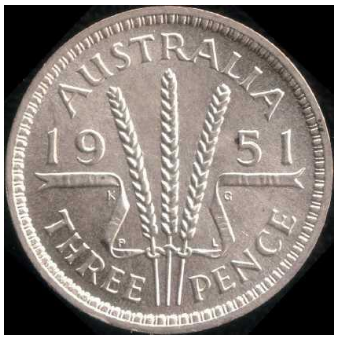
I was given a black covered note book which she had ruled up as a cash book on the left side was income and on the other side expenditure and to complete the exercise I was promised the large sum of nine pence a week to do with what I liked, provided I balanced my books each week, then I would receive the next payment.
Because I was nine years old I received that that amount I could hardly wait to turn ten. Occasionally I received special sums for Birthdays, etc or for special jobs around the house these had to be accounted for in my book. I soon got into the habit of knowing exactly how much money I had at any time, I was able to plan my trips to buy Radio Component from Price’s Radio House in Sydney.
I had been travelling by train on my own or taking my little brother Peter with me to Grandma’s place at Croydon ever since we moved to Berala, so it was no big deal for me to go to Sydney on my own.
I could handle money, I knew my way around and had all the self assurance of someone a lot older, I gather it was because I was such a stickybeak and I always asked lots and lots of questions to which I expected adults to answer truthfully if not I would keep it up until to get rid of me they told me what I wanted to know, it is surprising what one can learn with this method and learn I did.
Christmas at Grandma's
As far back as I can remember we would go to Grandma’s house at Bardy Street Croydon once a week, where my mother wo uld help her mother with the housework. Mum would do the washing and ironing while Grandma would do sewing for the family, Grandma made all of my clothes and my mother dresses on an old pedal Singer sewing machine.
When my Grandparents moved to Sydney from Murrurundi in 1917 Grandma started a Drapery Shop and dress making business and Grandfather started up with Uncle Les a Motor bodybuilding firm “Thomas Heywood and Son. After I start School at Croydon my grandfather would meet me after school and walk me to their home, he did most of the shopping walking to the shops at Burwood or Croydon. It was a family custom for all the family to go to Grandma’s for the evening meal on Christmas day. What a meal it was, Grandma knew how to cook and cater, especially for children, there was plenty of jelly and little butterfly cakes, not in round cake tins but in oblong ones. There were all kinds of cold meats and salads and other goodies for us all to eat.
The women were in the large kitchen the men under the trees in the shade with men’s talk while we kids were entertained by our cousins Betty and Joyce with all kinds of singing games.
We would eat and eat until we were “FULL” then we would roll on the lawn to feel better so we can eat some more. It was a never-ending feast; it made Christmas for us. Grandma’s house stood in a large corner block of land and up the back there was a car garage and by that a well made swing many hours were spent on it, but a Christmas time it was a case of rationing it out amongst the eight grandchildren.
My father did a lot of work around my Grandparents home. He turned the pantry into a bathroom and because the kitchen had two doors into it he changed part of the hallway into the pantry, he also extended the back verandah and lined it, the back verandah became a very large dining room just the place for Christmas gatherings.
The Apprentice
In the first chapter I spoke of starting my apprenticeship at Dairy Farmers Milk Company, now I will tell you all about it.
The first day I arrived at work dressed in a suit with collar and tie and a hat this was the way everyone dressed in those days, I had brand new overalls and my lunch, ready for my great adventure. What a shock I got I was given a broom by the foreman Bill Otway and told to sweep out the workshop.
There were “duck boards” in front of each work station which I had to raise and clean under then replace them, this took a while to clean and tidy the benches.
I was then told that I would be buying the morning teas and lunches for all who wanted them, I was amazed I didn’t know the area or our staff. Max the apprentice who had been getting lunches was pleased to show me the ropes and took me around to collect the orders and the money and shops to go to.
I was told this would be one of my jobs until a new apprentice started next year. The wages were poor in 1942, an electrician received seven pounds a week, and a first year Apprentice received eighteen shillings and nine pence.
My mother said that I should pay board now that I was working. We worked out that I had to pay five shillings for my concession rail weekly ticket so she charged me five shillings a week board with my lunch supplied -- it would have cost me six shillings a week for morning tea and lunch every day if I bought it. I was to bank five shillings a week for my future, and six pence a week went for my HCF, leaving me with only three shillings and three pence to spend a week - it was hard. I had no money so I could not get into trouble.
The Technical College system was going to change to daylight training half way through 1943 so the other Apprentices convinced Mr Lambkin to let us all start our Tech in first term in the day time - one day a fortnight for five years.
All the employees were expected to wear boots not shoes for safety at work so I had to save up to buy a pair of boots. What a surprise I got when at last I purchased my boots they were so heavy, I could not lift my feet high enough to step over the conveyor belts, it was embarrassing.
When I went to enrol at Tech I was allowed to start in second year because of my school marks in Physics and Chemistry. With the additional material I had learnt in my hobby playing with Electrostatics — remember the Whimhurst Machine - this concession was because of War time taking trained teachers to teach the armed forces trades people in electrical and electronics.
The exemptions were allowed, it suited me as I had an Extra year of paid Tech training to use at the end of my apprenticeship so I enrolled in the Pre-Diploma Course when I finished my Trade Course.
I was tall and skinny 6 stone (about 38 kilo) in weight at 16, so I was often used to replace the high lamps in the yard, two would support the back of the extension ladder with one person footing it while I would climb the 30 or 40 feet to change the lamps - what would Work Cover say today?
After six months my father decided that I needed a good set of tools so one Saturday we went to Sydney to one of the Wholesale Tool Merchants. There we bought a hammer, two screwdrivers, pair of pliers, hacksaw, Engineers square, inside & outside Callipers and pair of Dividers.
I still have the square, callipers and dividers after all of these years.
During my first year at work I contracted Viral Hepatitis, known as Hepatitis A today. It is a terrible complaint you can eat NOTHING, you keep nothing down the whites of your eye turn deep yellow or brown, skin colour changes, you have aches and pains everywhere, and you feel terrible. You are scared that you may die for the first couple of days, but then you are scared that you won’t die There was no known treatment at that time, only citrus juices helped.
I was sick for a month to six weeks and was still very worn out when I returned to work.
Changes happened when I entered second year, a new apprentice started so Len Fairfield took my broom and the meal orders and my duties changed. I spent a lot of time answering the phone looking after the storeroom.
One of my duties was writing out orders called “RECS” to be signed by the boss, when signed I walked to the Main Store and get the goods. I would go into the City with “Ready for Test Notices” or to pickup supplies from the Wholesalers. Not much to do with wiring etc. Len and I were good mates if fact we still keep in touch and talk about old times.
At other times I would work on the bench striping down motors for repairs. I had a seasonal job to clean, test and repair desk fans and room heaters I felt real important I was allowed to pick them up and d eliver them to the various offices around the buildings so I got to know the women who work there, they were nicer than the ones who worked in the bottling section.
Soon after I turned 17 I met a girl who lived in Park Road Auburn a stones throw from our home her name was Betty, we got on well, we both had bikes so we were mobile we went all over the place together. Our parents got on well we were one big happy family, we had holidays together at the Blue Mountains and at Aunt Elsie’s holiday home at Mona Vale.
This romance lasted for a couple of years. Betty wanted to get more serious and settle down, but I was not in a financial position being still in my apprenticeship on very small money so we decided to part.
I had a number of other girls who were always willing to go out with me at any time with no strings attached.
One such was Shirley her parents owned a Shop at Berala with a Post Office agency. I was never serious with her as she was a Jew, but she was good fun and we had some great times together we both understand that nothing would come of our relationship.
I found the Electrical Trades Course one of easiest course I have ever done it was as easy as most of the things that I was being taught at Tech I had some prior knowledge. The Final year
Examination was a three hour multi - choice type examination, this I finished in 20 minutes I then checked my answers and handed in the sheets and left the room only then did I realise the time I had taken. The Tech holidays were “Hell” I worried and worried that I had failed I was relieved to find that I had received a Credit Pass, and I have the certificate to prove it. With the completion of my apprenticeship came the time to apply from an Electrician License, now I was a proper Tradesman allowed to work on any types of Electric Installation Low Voltage or High Voltage unsupervised.
I was employed repairing installations for Dairy Farmers Milk Company in their many depots and because I now had my driver's Licence would be given any of the trucks available large or small to go to the trouble spots.
At other times I would be at Ultimo Head Office where I was stationed doing bench work. Designing low voltage transformers (mostly 32 volt or 2 KVA) or rewinding burnt-out motors or sometime designing and building large switchboard for installation in country depots. I had learnt to design lighting systems so I designed the layout for the lighting at the new depot at Pippitta.
In 1958 while I was an assistant Curate at West Tamworth I set about designing the lighting system for the new St. Paul’s Church West Tamworth. It was much to the surprise of the Vicar the Reverend Canon G A Baker who got an expert from Phillip Electrical to come up from Sydney; it surprised Canon Baker when the engineer confirmed all my suggestions for the lighting. By the way I was responsible for most of the wiring installation of the new Church; I built the main switchboard and even calculated the size to the consumer mains into the building. Our motto in the workshop was if someone made it we could fix it and most times we did, we could repair any kind of electrical equipment. So you can see that the training I received at Dairy Farmer Co-operative Milk Company Pty Ltd was of the highest Technical level we were more than just Trades persons. Most of the time I was happy working at Dairy Farmers, my work mates were helpful and at our breaks we were kept up the date with what was happening with plant and equipment, there were no secrets.
In fact our meals breaks were spent in gaining more knowledge about the new plant that the company had bought and was going to install both at head office and in the branches.
My Conversion
Looking back on my life it would be true to say that there never was a time that I did not believe in Jesus.
I attended church every Sunday with my parents from a very early age.
It was head knowledge not heart knowledge that I had.
After my confirmation by Bishop Hilliard in 1942 I started teaching Sunday school at our branch church St James every Sunday.
I was still teaching Sunday school until I entered Moore College in 1950. When I started teaching Sunday school was held at 3 pm.
But over the years Sunday school changed to the morning as attendances had dropped off as more people were able to own a motor car and thus they became more mobile.
In my mid to late teens (1946) I wanted to meet “girls” and what better place to do that than to join a church fellowship.
At our main Church St Stephens Lidcombe there was a Fellowship Tea once a month in the evening before evening service. So one afternoon I went to St Stephens to see for myself what was happening.
I found a small group of young people on the stage of the hall behind the drawn curtains the leader was a retired Missionary Clergyman (the Reverend Harry Arnold) and he was running a Christian Endeavour Group with a number of young people.
Behind his back we referred to him as “Uncle Harry” what a shock I got on joining the group he said we are now going to pray and with that he said to me you can start them off Bruce.
Not withstanding that shock I continue to go and the group grew so much that we had to move into the Kindergarten Hall out the back.
After a year or so we then came back this time to the large Hall as we had outgrown the Kindergarten Hall the attendance each Sunday had become so large.
I was involved in all kinds of activities around our Church. Various speakers were selected by our Rector the Reverend Gordon King for Fellowship Tea each month we had nothing but the best of speakers.
One Evening we were addressed by the Senior Student from Moore Theological College Roy Gray, he later was ordained and served in a number of Parishes , it was after that service that I made a commitment to serve the Lord Jesus until my life’s end. It wasn’t long before I was appointed to the diocesan board of Christian Endeavour in Sydney where we met in the Deanery. And I also started to assist Gordon King at the evening services by reading the prayers.
In 1950 I started training for the Anglican Ministry, we were then known as the “Church of England in Australia” at that time.
It was three years of solid study something I had never experienced, study and more study, the Bible was read again and again and we were examined on the passages which we had to know fully with all the details and arguments etc. It was an interesting time and one of great preparation for full time teaching of the Scripture and Church History and other matters associated with the Church.
Remembrances
My brother Peter Holland wrote: - “My first memory of my Great-Grandmother, Sarah Danswan (nee Gimbert) was when my mother took me to my Grandmother’s (Mary Jane Heywood nee Danswan) home at 33 Brady St., Croydon for a days visit. We were in the family room when a tall white haired lady pushed through the drapes over the doorway. She was dressed all in black (being a Widow) and her Taffeta neck to ankle dress made a rustling noise.”
Peter was about 3 or 4 years old at the time, he screamed & screamed at the ghost like apparition. He wasn’t the most popular great grand child as you would imagine. Sarah Gimbert was born in 1847 in Sutton, Cambridge England. She arrived in Sydney as a babe in arms with her parents Ephraim & Sarah Gimbert on the Sailing Ship “Castle Eden” in 1848. She married Thom as Danswan, a Chinaman, on 28/12/1864. Family myth has it that he bought this 16 year old girl from her impoverished parents for a bag of wheat or wheat flour.
As I have a Great-grandfather who was born in China (Thomas Danswan) this makes me 1/8th part Chinese.
Notes
For those who don’t know one pound note was equal to $2 at conversion in February 14, 1966. My paternal grandfather George Holland migrated to New Zealand and later move to Sydney he was a master builder and owned brickworks he married twi ce her second wife was my grandmother Ellen Fox ... My maternal grandfather Thomas Heywood migrated from England and joined the Salvation Army and was appointed as an Ensign to Murrurundi where he met my grandmother Mary Jane Danswan. Thomas was then assi gned back to Sydney and became a captain, but he suffered from a heart flutter and they discharged him on health grounds. It wasn’t long after that he returned to Murrurundi and married Mary Jane. My mother na me should have been “Ameldia Isabel” not “Em elda Iso bel” as my grandfather was a poor speller having left school at the age of twelve to work in the Cotton Mills. Both my Grandmothers families came to Australia early in the 1800’s Regards Bruce.
Additional Notes
My great-grandfather Henry Holland owned brickworks in Leyland Manchester England. Henry was a better brick maker than a book keeper , but he was able to clear up his debts and fix up his affairs
When Henry settled his affairs in England he migrated to New Zealand arriving 24th February 1860. He also received a land grant there.
In 1862 his wife Lavinia and at least two of his sons and some of the daughters (10 children in all) migrated to New Zealand 17th October 1862.
Sometime later George and his brother Horatio came to Sydney to live and work in the building industry. George owned parcels of land about Sydney . Brickfield Hill was one, he had a large parcel of land at Pittwater and building sites at Berala there may have been more but this is all that I know about . George built a home at Marrickville called “Bayswater” while Horati o lived somewhere in Redfern. My grandfather organized the building of St Clement Church Marrickville I have seen the framed “Illuminated Address” which was given to him by the Parish at the completion of th e project I have seen the graves of George and Ellen at Rookwood Cemetery also sighted Horati o and his wife ’s grave there as well. George was responsible for building Terrace houses in Surr y Hills then known as “Strawberry Hills”. Because he owned Brick field hill he was able to build Anthony Horden’s store on that site for them. It later burnt down in 1901 about the time that G eorge retired from building he was 45 years old. My grandfather then spent the rest of his life setting up br ickworks and Cemen t factories. He was a director of a large number of companies including a bank. There is a street called Holland Street in St Peters where the brickworks once stood. George Holland married twice the first wife was Mary a daughter of Mr Mulligan who was t he honorary counsel for Chile . Georg e had three chil dren by his first wife only one lived to be an adult . After Mary died George married again this time to Ellen Fox who was my grandmother. I think that Ellen was a cousin of Mary and she had looked after Mary children.
Ellen father was the Sexton at St Matthews Church Windsor he is buried in the Church yard at Windsor.
George and Ellen had eleven children of which my father Norman was the youngest. As a child his elder sisters called him “scraps” because he was the last of the bunch.
My grandfather George died ten days after I was born October 30, 1927. He was blind in both eyes possibly from Macular degeneration as my eldest cousin on the Holland’s side has that disorder.
The Story of Elaine by Bruce
This section is dedicated to my wife Elaine Frances Holland nee Kitchener Born February 8, 1932 Died February 18, 2010.
She was the sweetest caring person one could know. With her passing I have lost my help-mate I don’t know what the future has in store, but I know I will be lost and very lonely.
Her favourite Bible verse I leave with you.
“Trust in the Lord with all your heart and lean not on your own understanding, in all your ways acknowledge Him and He will bring it to pass.”
Proverbs 3: 5 & 6.
Elaine
Where does one start with Elaine’s story? I will start by looking at her family, and telling you what I know and what I have gathered over the past nearly sixty years I have known her. The Kitchener family migrated from England in 1853 on the “MAIDSTONE” when the Colony was opened up for settlement. They established a farm in the Prospect area on land adjacent to where the now Prospect reservoir stands. There was a “Blue Metal” quarry either on their land or very close by , the original home was on the side of Prospect Hill. After looking at the Family History one discovers marriages between the Kitcheners and descendants of convicts. William Robert Kitchener Elaine’s paternal Grandfather married Mary Ann Jennings in March 20, 1895 and they lived in Merrylands Road Greystanes. Elaine’s father was youngest of the seven children; he was born November 16, 1906. Elaine’s mother was Frances Alice Ethel (nee) Charnock her family lived in Arcadia St Holroyd her father was a marble mason and it appears as if he died of a “Dust Disease” as he died younger than most at that time.
Elaine’s mother Frances and father Arthur Kitchener were married November 16, 1929 at Merrylands West Anglican Church ...
They had eight children five girls and three boys and Elaine was the second eldest of the group so it was a large family to provide for in the dying days of the “Great Depression”.
The family set up home at 393 Merrylands Road Merrylands West opposite a mixed business which Frances ran during the week while Arthur (Todge) worked at what ever he could get as there was little call for a Boilermaker in those hard days, for a time he worked in the Brickyard making Bricks. It was at this time that Elaine decided to prepare for her future she opened a saving account at the Commonwealth Bank and bought herself a wardrobe which she turned into a glory box or hope chest. When we married it was full of linen and towels etc and a lot of fancywork which she had done, it was packed full. I think we are still using some of the things after all these years. Elaine spent many happy days at CUA until she married me. Elaine's father was very strict with the family and made sure that they had a Christian upbringing, he saw that they attended Sunday school, and later as they grew up , they became regular worshippers at Church. Also Elaine joined the Church Fellowship and Christian Endeavour group. The Christian Endeavour group met in the Public Hall at Greystaines it was an inter-denomination group (Elaine played the piano for them.) It was at a church fellowship meeting that Elaine meet Edward(Sonny) Hussey and they began seeing a lot of each other so much so that when Elaine and myself became engaged people thought that it was Sonny not me who was the one.
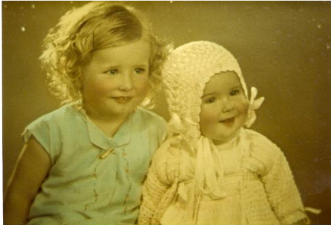

At an early age Elaine showed her love of music and singing so her Aunty Myee who was the Church organist taught her to play the piano but she was so small she was unable to reach the pedals and keyboard at the same time.
Because she had such a lovely sweet sounding voice aunt Myee taught her how to sing, and they were only singing lessons she had.
Elaine often spoke of riding her bicycle to Parramatta markets to buy stuff for the shop, she would have been 10 or 11 years old at the time and as a reward she was allowed to wear her mother’s best short coat for those journeys.
She also told of the Bicycle accident, she and Val had when they came a buster ”on the gravel"; she still had signs of the gravel rash to her dying day.
In 1944 Frances their mother died in child-birth, she was buried together with her still-born child at Rookwood Cemetery. What an experience for twelve year old Elaine to have lost her mother like that?
The changes in the family were difficult for Grandma Charnock was blind (she had cataracts on her eyes) so she was limited in her help, while Grandma Kitchener had a farming property at Greystaines.
So it fell to Rosemary her older sister and Elaine to look after the younger children.
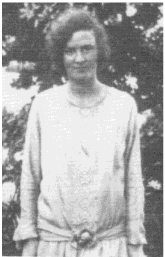
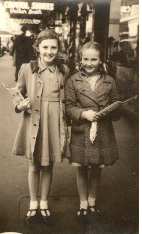
Rose left school to look after the house and cooking while Elaine became mother and took care of the little ones, Val, Merle, Cliff and Wendy, while Max and Arthur went to live with Aunts ...
After obtaining her Intermediate Certificate Elaine like most us of that period left school and went to work. Before starting work she went and enrolled in a shorthand and typing Certificate class at private evening training schools for clerical work.
Her first job was at the Church Standard Newspapers in Sydney where she was expected to do most of the tasks in the office as most of preparation of the paper including editorial tasks were done by volunteers.
She was expected to address, deliver and proof read the paper, a big task for a very slight 16 year old girl.
When one of the worshipper at St Matthews found out what was expected of her at the Church Newspaper he offered her a position at Commercial Union Assurance Company in Pitts Street Sydney, where he also worked.
It was at this time that Elaine decided to prepare for her future and she opened a saving account at the Commonwealth Bank and bought herself a wardrobe which she turned into a glory box or hope chest. When we married it was full of linen and towels etc and a lot of fancywork which she had done, it was packed full.
I think we are still using some of the things after all these years.
Elaine spent many happy days at CUA until she married me.
Elaine's father was very strict with the family and made sure that they had a Christian upbringing he saw that they attended Sunday school and later as they grew up, they became regular worshippers at Church, also Elaine joined the Church Fellowship and Christian Endeavour group.
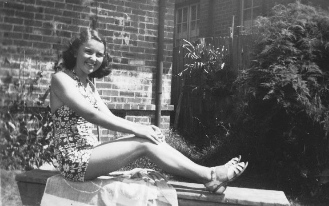
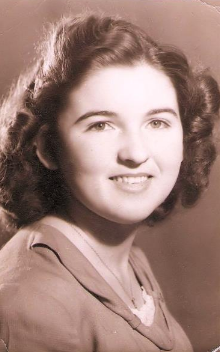
The Christian Endeavour group met in the Public Hall at Greystaines it was an inter-denomination group (Elaine played the piano for them.)
It was at a church fellowship meeting that Elaine meet Edward(Sonny) Hussey and they began seeing a lot of each other so much so that when Elaine and myself became engaged people thought that it was Sonny not me who was the one.
Elaine's History now became ours
From now on the story of Elaine is combined with mine. I first met Elaine singing the lead in the Musical “Zerica” T here was this tiny nineteen year old girl with a powerful sweet voice I was enthralled by her. I could not take my eyes of her, by the end of the night I had made up my mind that this was the girl I was going to marry, but of course Elaine had other ideas. At the end of the next fellowship meeting I politely asked her if I could drive home to Holroyd, she refused saying that she would be walking home with her cousin Dorothy. So I had to wait until next week this time I tried a different method I got in first and asked Dorothy would she like a lift, she said certainly so Elaine followed , I had my brother’s Baby Austin Car I made a detour to drop off Dorothy first and then Elaine this gave me time to speak to her outside her front gate.
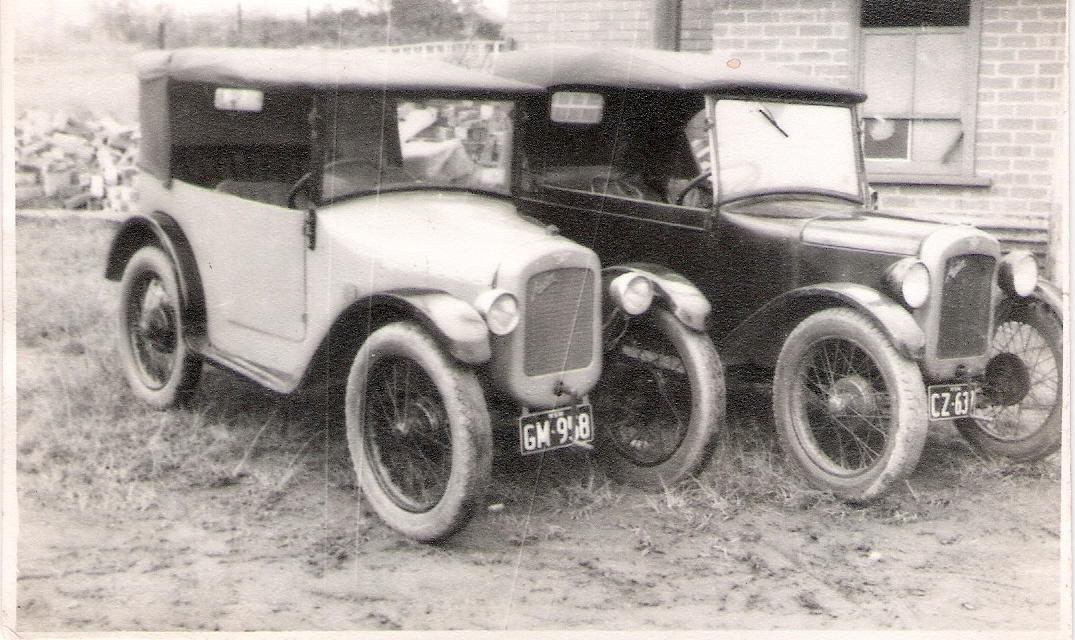
As my brother Peter had sold his car I borrowed dad’s car for my next attempt to try to influence her, it was a large prewar powerful Morris 25 HP car. Three fitted on the front and four across the back. By week three Peter had another car so I was allowed this one as well. This appeared to do the trick, she must have thought that I was RICH when in fact I was a very poor Theological Student, so we started to go out on our own together. Our first real date was to Auburn Pictures all night I kept looking at her I don’t know what the picture was about, I had only eyes for her. I thought how small she was, I felt as if I was taking a child out instead of nineteen year old girl out.
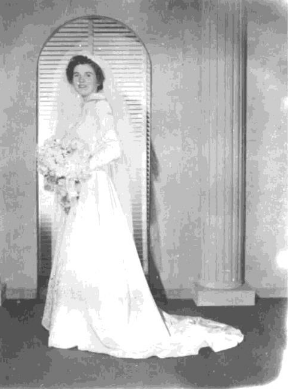
We had a 3 years engagement as it was the policy of the then Archbishop of Sydney to require his candidates for the ministry to be single and not marry until after their deacon year.
Next I was appointed as Catechist at Campbelltown Anglican Church, Elaine and I would travel to Campbelltown each weekend.
Elaine would help the Rector’s wife with the housework and looked after her children while I assisted Rector with some of the many services in the Parish we were made to work and work we did.
(Because I was a private candidate I decided to get married and seek ordination later as the three year engagement was a drag. It would have been 2 or 3 years more before we would have been able to marry. )
We were married on February 20, 1954 by the Reverend Gordon King at St Stephen’s Church Lidcombe.
It was a very wet time there were floods all over the State and we had decided on a travelling Honeymoon on the south coast of New South Wales, as Elaine had never travelled that way before. We were lucky the flood waters receded the day before we arrived in each town on the way down the coast ...
(I have just found the telegrams which were sent to us for our wedding Elaine kept them in her treasures for 56 years!)
Elaine was so well liked by the management and staff at The Commercial Union that they wanted her to take the position of head girl in the office it was to be a replacement of the person who was occupying that position already.
This Elaine refused to do so and it was because of that request and her loyalty to the woman who was in charge, she used our marriage as an excuse to leave.
For the first six months of our marriage we lived at Berala with Mum and Dad Holland and Peter so it was a very crowded house. But it was also very cosy as we slept in a 3 foot bed (900mm wide) for the six months.
It was not a good idea to start married life in such a situation so we looked for a means of getting into a place of own, housing was in very short supply in the 1950s, and as I now had limited finance having spent all my savings paying for tuition at Moore Theological College for those three years we were broke. At last Elaine found a Block of Land at Chester Hill with Garage on it for sum of 400 pounds.
We were able to buy the property with a deposit of 250 pounds it was all Elaine had in her bank account.
We lived on my wages as an Electrician and used Elaine wages at Concrete Industries to pay the instalments on the property.
While Elaine was working for Concrete Industries she was given the opportunity to buy shares in the company at a very good price, but as we were as poor as “Church Mice” she was unable to take up the offer. If she was able to do so we would have had a good “nest egg” and would not have lived here at Narara.
After a couple of years at Chester Hill where I was Catechist at St John’s Sefton We applied to the Right Reverend J S Moyes Lord Bishop of Armidale for ordination.
Bruce was made a Deacon in St Peter’s Cathedral Armidale in April 1956 he was appointed as assistant Curate in the Parish of St Paul West Tamworth. What a shock we received when we went to West Tamworth Parish, the residence we were expected to live in was of a very low standard it may have been a brick cottage, but it was run down.
It was subjected to flooding in fact the year before we came the water was up to the window sills.
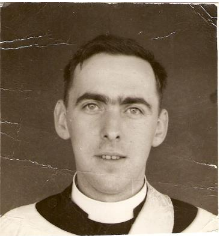
On entering house one came into a very large room which was divided by a wall made of tongue and grooved lining boards place vertically, the boards were less than 20 mm thick. Thus we had a lounge/dining room and on the other side was the main bedroom. Then through a doorway to a small kitchen and an even smaller fuel stove the firebox was so small that each piece of wood had to be cut in half in length to fit in it ...
Opening off the Kitchen was a second bed room which I used as my study, it was very tiny we also fitted a spare bed in there for visitors. Out the back was a long veranda and opening off that a bathroom with toilet in it, the next to that a very large laundry, I used the laundry as a Radio shack and workshop.
On washing days I had to evacuate it so that Elaine could do the washing.
In the laundry I found a bicycle hanging on a hook I asked the Canon Baker whose machine it was, he said it was the Curate's mode of transport.
I told Canon Baker no way was I going to visit on it as we had our own car, so the bicycle may be still hanging in there as far as I know for all the others curates after me had their own cars as well.
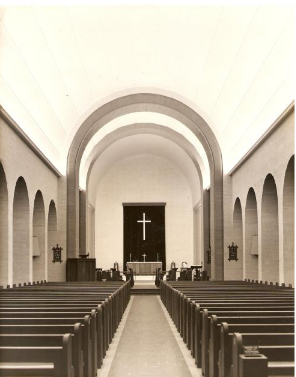
When the Canon found out that Elaine could play the organ she was put on the roster to play, it was a large organ you could pedal it but there was a handle out of the side which one of the choir boys pumped. Sometimes the organ would run out of air because the lads would take a rest.
When the Wells campaign began in the Parish they used Elaine’s typing skill too in the office.
I was given a number of country schools which I visited regularly and Elaine always came with me for company and we would have a picnic lunch along the way between schools. So you see we were very involved in that Parish. It was at West Tamworth that our first child Ralph was born in August 1957 Elaine was 25 years and I was 29 years old.
When the tower of the church was finished Elaine wanted to witness the view from the top of the tower so I carried Ralph all the way up the stairs and up the final ladder to the top, it was a great view but Ralph does not remembered much about it.
I had one of the longest Curacies because I held an Electrical Contractor Licence and the Parish was building a New Church by volunteers making handmade Concrete bricks.
There were other Electricians living in the Parish who help sometime but most of the work fell on my shoulders, the Lighting design, the PA installation, intercom which I designed and built and even the lightening protection of the tower, I built the main Switchboard and calculated the size of the consumer mains and made the concrete pillars and installed all the outside floodlighting of the building and on the top of tower as well with a light on the Cross on the top of the tower (and it is still working to this day).
So you can see that my training at Dairy Farmer Milk Company came in very handy.
We were still at St Paul’s for the opening of the new church in 1959 after which Canon Baker went on holidays and I was left in charge of the Parish.
On his return from holidays Bishop Moyes gave us our first Parish which was Delungra and I became a Vicar, did that make Elaine the Vicar’s Gin???.
The parochial district at Delungra was about 20 miles west of Inverell, it had been a parochial district for 60 years and would still be, but now it has been combined with another district.
A funny incident occurred at Delungra, one morning on going to collect the mail from the Post Office I met for the first time the Roman Catholic Priest I tried to speak to him and introduce myself, but he being a true Irishman ignored me.
The next Saturday I got an urgent request from the Nuns at the convent. “Was it true that I was trained as an electrician and if so would I be so kind to help them as the lights in the church had failed and there was no one to fix them and they needed the lights for tomorrow’s Church Service.
I went and found a short circuit in the sacristy I made a temporary repair and told the mother superior I would correct the trouble on Monday which traditionally was parson’s day of.
On Monday I replaced the damaged wiring and thus fixed the fault. They asked me how much when I said “Nothing!” they were very happy as they were very short of funds, the same as our parish was for the price of wool had dropped drastically.
The next day I got a telephone call from Father Rohan thanking me for being so generous. Every time he saw me after that he would stop and have a long talk to me about things “clerical” etc.
Years later when we were appointed to Tenterfield Father Rohan was the Roman Catholic Parish Priest there, he invited me round to the Presbytery to see him.
We became the best of friends, but I will tell you about that later in our story.
I got the idea that to save for our future we should try to run our car from our stipend and bank all of the car allowance in a special account this would enable us to buy a new car when the time came to do so.
Up to now all the cars had been second hand ones and the “bombs” were very unreliable. With careful planning we saved over a thousand pounds.
At last the time came to buy a band new car so I went to see the Bank Manager to withdraw the thousand pounds we had in the car fund to buy a brand new Holden car. He suggested that I do something different, he said “borrow the 1000 pounds from the bank, place your 1000 pounds on fixed deposit and I will charge you one percent more than the interest on the fixed deposit.
He said “you will have your car, you will still own your thousand pounds and you can claim the interest on your tax return, and when you pay off your loan with the car allowance you will be in front .” this I did and it helped put us on our feet. This way the car was paid off before we left Delungra.
The day Ralph left home
One day after correcting Ralph over something he did, he informed us that he was going to leave home.
Elaine was upset and was troubled as a mother would be, not I for I was prepared for that day.
When I was an apprentice the older men in our group were discussing this very matter.
One of them said when his boy was younger the lad wanted to leave so he help him. He packed his things and showed him the door, in a little while there was a knocking at the door for he had returned never to leave again.
I said to Ralph so you want to leave home, good I will help you pack. I tipped out his toys from a suitcase and packed a change of clothes, his teddy bear, pyjamas and his toothbrush.
I then said say goodbye to mummy and then he left.
We watched him going through the bedroom window, he crossed the road, then railway crossing and down the hill he went.
Elaine said to me to get the car out and go for him, I said no let us wait. After what seemed ages we saw him returning home he had decided that home was best.
Because of my experiences as a child nothing surprised me I anticipated most of Ralph’s action for I had been there and done it.
Once when he was being difficult and wanted to do something he started banging his head on the floor he said he would keep it up until we gave in.
I as helpful as ever said to him if that is what you want to do I will help you and with that I assisted him in banging his head with a little bit of extra force.
It hurt this time so he soon stopped.
At Delungra we start our long line of pets a bird in a cage and a dog in the yard, they were Ralph’s but you know who had to look after them -- Mum
Delungra
It was at Delungra that Elaine fell pregnant with our second child but it was not to be for part way through that pregnancy she had a miscarriage and ended up in Inverell Hospital. We had great friends Noelene and Reg Stockman (Reg was Radio Amateur) theywas lived in Inverell Noelene had Elaine come and stay with her for a time to get over the miscarriage.
A year or so latter Elaine was again pregnant and this time she when full term but had a very difficult time with a 32 hour labour it was possibly caused by the onset of Arthritis which runs in her family. When Elaine went into labour she went to hospital and waited, and waited I would drive in to Inverell eac h evening to the Hospital, sleep over night on a bed in a spare ward waiting for the events to happen. I was present for Mark’s birth it was not the done thing for a husband to be in the labour ward in those days The Nurse was not happy she put me out and Dr Charles Holmes who was a great friend to both of us he made me come back into the room. .
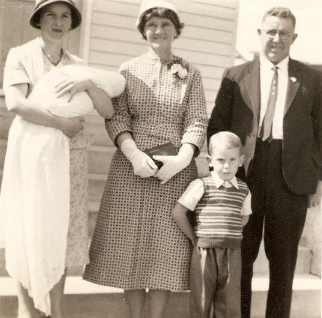
Mark was born in March 1962 when Elaine was 30 years old it was 5 years before the signs of Arthritis appeared in her hands. The Reverend L Seymour was Vicar at Delungra before me he was responsible for building the new church , but it was left to us to pay the place off so Elaine and I thought up all kinds of fund raising ideas. At last we succeed and had the building consecrated by Bishop Moyes.
We then altered the old church and turned it into a proper parish Hall we removed the old sanctuary and vestry then we built a large kitchen and which we fitted out with cupboards.
Elaine and I painted the inside of the hall one evening. Two young men came to see us when they saw what we were
doing they went home and came back with painting clothing and helped paint the ceiling saving
Elaine the trouble of getting up on the scaffolding.
At Delungra I experiment with receiving TV from Brisbane and I build a special antenna to receive it. We were the talk of the town.
When Toowoomba TV started up we had regular grainy picture to watch.
After nearly 5 years at Delungra the Bishop nominated me for the Parish of Bundara, he said “They needed someone who was strictly honest”.
Bundarra

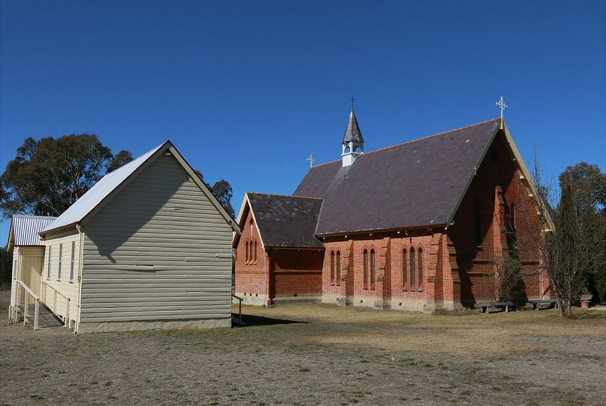
Bundarra was a long established Parish older than Inverell. Before World War
II the town had a population of about 3000 people. but most the people never returned to Bundara after seeing the rest of Australia and the World. When we moved there the population of the town was about 400 souls.
There was no organist at Bundarra so you know who became the Church organist.
It was the first Parish we had where the Church and Vicarage separated by distance, it is good in one sense but a nuisance in another for what one wanted was always the other place, so you run backwar ds and forwards in the car all the time. But it is more private being away from the church we had less callers and it was better for the children and their TV.
The Parish was in debt it had been mismanaged badly all sorts of things were wrong.
It was a great shock to realise the extent of the debt so we both worked very hard to raise the necessary funds to keep the Parish solvent and because we were able to pay the debts outstanding we were known as experts in Church finances and the raising of funds.
One of our fund raising efforts was to collect and sell scrap cast iron. We made a collecting point in the Vicarage ground and people brought piece of cast iron to the heap from all the rural properties and the town yards. We when then transported the iron to the foundry in Inverell in a number of trunk loads and in return received a tidy sum.
Instead of evangelising the place we both had to work hard for we both liked to eat. At Bundara the local Chemist’s wife had said she would be the first person to get TV in town.Can imagine how she felt when the poor parson arrived in Vicarage and had TV reception in the first week of residence?
The Parish of Bundarra always had a Parish Ball it was one of their chief fund raising events Elaine needed a Ball dress we co uld not afford to buy one and there was no one in Bundarra that we knew that would make Elaine one at a price we could afford.
I said to Elaine why you don’t make yourself a ball dress. To which she said I would if I had a Pattern. I told her that would be the easiest part of it I could make her a pattern to fit her if she would get the material.
Elaine bought a dress length it was peacock blue material so I set out with the Inverell Times as the paper to make a pattern for the dress. This I did, in fact I enjoyed fitting her with the pattern oh how she wriggled as I fitted her into the pattern and again in the pieces of the dress ...
Dress material was cut out on the lounge room floor, and then Elaine sowed it up. We both like what we saw when it was finished. She didn’t look too bad, it suited her.
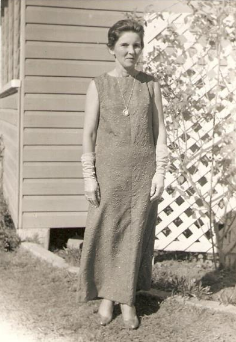
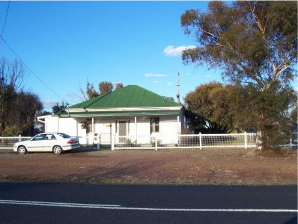
During our stay at Bundarra the Reverend Billy Graham came to Sydney for his second crusade, we organised a landline connection and used the School of Art Building. Attendance at each night was great, the hall was packed but we had problem organising counsellors we had but three people to speak to those who wished to receive “Christ as their Saviour”. What shock we received when Billy made the appeal at the end of the final meeting, there the whole company stood up and we were only three of us. Elaine, a lady from the Baptist Church and me had to handle this great number people we f elt we knew how the disciples were on the day of Pentecost. It was a late that night when we finished and closed up the School of Arts.
Elaine had very bad health problems while we were at Bundarra she lost her voice many times, she suff ered continuous thrush, she had her tonsils removed.
She had a hysterectomy and ended up in Armidale Hospital with Septicaemia and not expected to live.
After the bout with septicaemia the first sign of arthritis showed up painful swelling in the hands and feet and a general feeling of fatigue .
In 1967 Arthritis showed its ugly head brought on by the extreme cold of the winters in Bundarra. Our water pipes would freeze even the sink waste water pipe froze solid, the only way was to go out side and pour hot water over the “S” bend to empty the kitchen sink.
Elaine was not her happy self; every thing was an effort for her. She found the extreme winters weather effected her circulation, her fingers would go white and she would lose the fee ling them the only relief she could get was to soak her hand in warm water until the blood flow increased.
It was at this time that Elaine developed extreme pain under her right lower jaw the cause of which the local doctors could not discover.
Things improved in the Parish, the finance were better. I didn’t have to worry that the bank manager (he was the Church treasurer) would saying to me that there was not enough money in the church account to pay me.
So I was surprised one day when he called me into his office for a chat. When I got in there he said to me “I shouldn’t be saying this to you as I am the bank manager, but do you know that you can get better interest rate on that 1000 pounds you have on fixed deposit”.
I said “no tell me more.” then he explained that he had all his funds in the finance company CAGA their interest was double the bank’s interest rate and it was owned by his bank and was quite safe.
So we transferred the money to CAGA and we were now able to reap the benefits of the rising interest rates and we found out that we could compound the interest as well.
As the economy improved so did the interest rates and when it got above 10 percent with the investment compounded for 5 years we double our principle?
While we were at Bundarra Census time was approaching and the Undertaker at Tingha was responsible for enlisting people to assist with the Census he asked me if I could do with some extra money I said “Yes please” so he told me about the Census how easy it was and that the money was great.
After I said yes he told me that I would be responsible for quite a large area fortunately the area was sparsely populated.
There were one area which was difficult to get into and when I asked the local policeman about the road he said he would take me in the police car as he needed to go to the only farm on the far end on police business he wanted company and he told me it would save wear and tear on my new car which I had just bought. . Soon our time at Bundarra was finished so we were offered the Parish of Werris Creek. The move was influenced by the need to find a town with access to a full High School for Ralph was nearing High school age.
Werris Creek
Werris Creek sounded great, it appeared to be prosperous town wheat and sheep farms made up the area, with a large Railway Workshop, and it was an important Rail Junction.
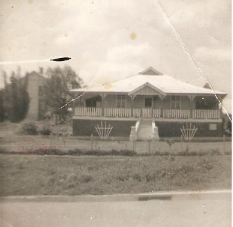
Parishes were always presented to the prospective Vicars in glowing terms, it was only after one's induction that the true facts were made known. Werris Creek was “broke” as much as Bundarra if not more so.
The problem with Werris Creek or as the locals called “Where it Werris Crook” was that most of the farming community would not associate with the rail employees and their wives, they were more interest in going to Quirindi or the Tamworth for their worship. As the railway employees were paid fortnightly and most families were poor managers, the Parish income was normal “pay-week” and very low “off-pay-week”.
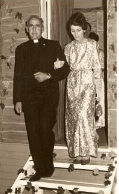
The town of Werris Creek at that time was like the inner city suburbs of Sydney or Newcastle for most of the railway people came from those places.
It was at Werris creek that a specialist in Tamworth was able to diagnose that Elaine had a stone in her submandibular gland the size of a marble.
She was admitted to Tamworth Hospital where the stone and gland were removed.
We no sooner arrived in Werris Creek and found that the Sanctuary part of the church was at the point of falling down, it needed to be rebuilt.
The nave of the church was in brick, but the “parson’s end” of the church, the sanctuary, was of weather board construction, and it was the last section of the original church. ...
I got the idea of turning the church around using the porches as vestries. The western end the church had a beautiful stained glass window which came from England from a redundant Church. We extended the east end with a ten foot brick section which cost as much as the original brick section of the church in the 1930s.
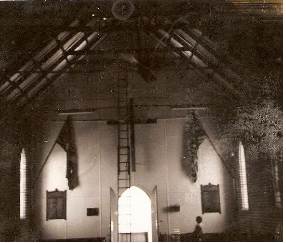
It was fortunate that we had completed the reorientation and paid for it when the whole of the North-West of NSW experienced one of the worsted droughts. Farmers everywhere were going bankrupt and at Synod the Bishop (RC Kerle) announced that the Diocese would be bankrupt in the near future if it didn’t rain.
The rail people stopped giving to parish as they were not really interest in the Church, they were only in town to get promotion to better places. I could see that I would not be getting paid in the near future so with the Bishop’s permission I set about looking for secular employment some the other clergy took on cleaning work but because of my Electronic ability I was able to be employed as a Television Service Technician with Malvern Star at Tamworth.
This position I held for over 12 months until things improved.
(I was being paid more than the Bishop, but we lived, as if we were only receiving a clergy stipend, we banked the extra for a rainy day and did the rain come? It did later on when Elaine's health worsened.)
After my stay at Malvern Star I continued working as a TV tech part-time for another 12 months, thus helping the parish get into a stable position. When the parish was able to sustain itself I asked the Bishop for another Parish, and after a short wait I was nominated to the Parish of Tenterfield.
Tenterfield
At last we were in a Parish which could really support a clergyman; it had a large population of praying people.
All parishes have problems but Tenterfield’s were of a different kind, here we had too many organists we needed to draw up a roster and juggle around the players so they each got equal number of turns on the organ.
The Vicarage was large and roomy the people were friendly and responsive, attendance were large the services were always crowded, But Tenterfield was cold even in the summer you could get a chilly breeze.

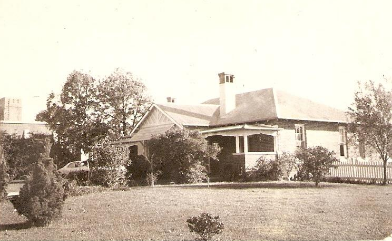
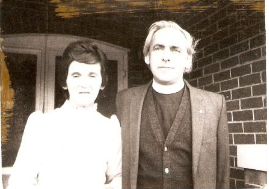
Now I will complete the story about Father Rohan, I no sooner arrived in Tenterfield when a message arrived from one of the Roman Catholic Nuns saying that Father Rohan wanted me to call on him tomorrow if possible I had no idea what he wanted. When I got there he wanted to know all about my previous appointments in the diocese and how my family was and all about us I was to call in any time to see him he said he was getting too old to get about much but he wanted his people to work with the Anglican C hurch as much a possible to preach the Gospel to the people of Tenterfield., I came away elated.
Oh how the devil works.
Every Christmas and Easter the Choral society of Tenterfield would hold a Religious Concert in the Anglican Church as the front section of church was raised like a stage we were coming up to a Concert in a couple of months (it had been advertised even before my induction) but a “war” erupted among the members of the choir, there were those who were worshippers in the Churches who wanted to sing in the Concert, but there were others who said we sing too much religious stuff let us not have a concert this year.
I was told that the concert was to be cancelled and did I go into a flip I rang up the Minister’s fraternal members to tell them and as I said to them I know Father Rohan well I will call on him and tell him we will have to cancel the concert this year.
On going to Rohan he said to me why don’t the Churches themselves put on the Concert I am behind you in all that you do. I will tell my congregation to help you as we have a lot of singers and I am sure they will be willing.
The long and the short of it was that we formed a Combined Churches Choir with singers from all the Churches. The Concert was the best in attendance for some years and I believe that the performance was also the best ever, or so everyone told me.
A couple of years later the Choir recorded a session for the ABC’s church choir program for which the choir was paid a fair sum of money.
As Tenterfield had an eisteddfod every year it was not long before Elaine was enticed to participate in it. She was still able to fill the “School of Art” with her strong sweet voice, this without the use a microphone. She was surprised when she gained a number of first prizes in the competitions.
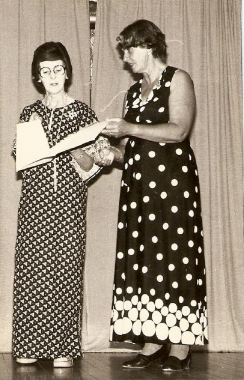
She was then asked to go to the Inverell eisteddfod by one of the ladies of the choir who went to all the Eisteddfods around the place taking out the first prizes.
What shock she got Elaine beat her in most sections, I think that she was sorry that she asked Elaine to go with her. Although she did tell Elaine about later Eisteddfods and even took her to most of them.
parish hall
When we arrived at Tenterfield we found that the Parish had a lovely Church, a good Vicarage.
But it had a ramshackle parish hall it was the original church in Tenterfield it had been erected on the other side of town but was removed and re - assembled on the site.
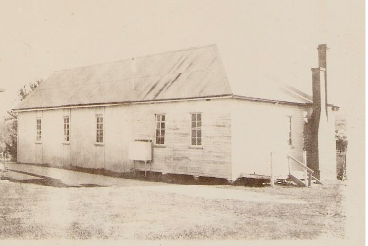
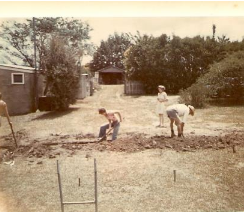
It was made of slabs of timber placed vertically with When I asked why we don’t have a better hall I was told there was a building fund of $5000 but it was not en ough to build the planed Brick Hall they wanted. I told the Parochial Council that I knew how to build a Hardiplank hall if they wanted one. They told me that the Town Council require a brick building. The next day after that meeting I visited the Building inspector to find out the truth. He was the one who had drawn up the plans for the parish to build in brick, he said to me it would be easy to change the design to Hardiplank and there was no requirement by the council to build in brick.
I sent the plans to the diocese and they approved them gaps between the boards it was very cold in winter and draughty.
When I asked why we don’t have a better hall I was told there was a building fund of $5000 but it was not en ough to build the planed Brick Hall they wanted. I told the Parochial Council that I knew how t o build a Hardi plank hall if they wanted one.
They told me that the Town Council require a brick building. The next day after that meeting I visited the Building inspector to find out the truth.
He was the one who had drawn up the plans for the parish to build in brick, he said to me it would be easy to change the design to Hardiplank and there was no requirement by the council to build in brick.
I sent the plans to the diocese and they approved them.
The Parish had been trying for 50 years to build a hall they had even collected a lot of the materials before World War II. At the start of the war the materials were reclaimed for use in the setting up of the many military camps around the town. We built the hall by voluntary labour I was clerk of works and looked after the building work during the week then with the help of a licensed builder on Saturdays when most of men of t he town would front up for work on the building.
We promised them “on the job training” and train we did, even our solicitor was up working on the roof and he enjoyed it after he got use to the height.
Elaine organised the morning and afternoon teas for the workers.
Each evening after the folk had finished and gone home Mark and I removed all the materials and clean the site so we had no accidents because there was nothing to trip over or hurt anyone.
When we finished the hall free of debt I checked on the building Fund and found that we still had the $5000 in it ...
The money was then available for other works .
I could see that we could be in trouble with the old hall for someone organised the old school building to be heritage listed so I made hast to remove the old eyesore hall. Originally it was intended to move the old hall and keep it, but the upkeep would have been great. We got a good quote to demolish and remove the building and it was gone before the “conservers” could get their hands on it . ..
Elaine's Arthritis was getting worse our local doctor was trying all kinds of treatment without success. I now think that it was the treatment that she was getting was making her troubles worse. Elaine found it impossible to dress herself I had to become a dresser of females even her undies I didn’t mind that but she kept on telling me I was not doing it right. I said I not a expert in dressing women haven’t any practice at it, I am only expert in undressing them , she was not pleased.

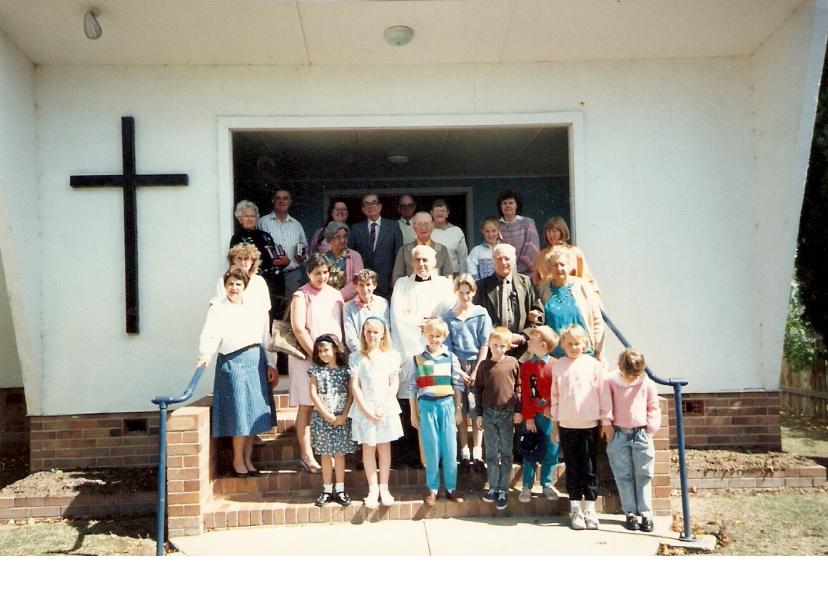
Every Sunday after the two morning service in the parish church I would travel over the State border to Wallangarra Queensland to take a service there.
It was in the parish of Stanthorpe but we were a lot closer.
When we finished the hall free of debt I checked on the building Fund and found that we still had the $5000 in it ... The money was then available for other works . I could see that we could be in trouble with the old hall for someone organised the old school building to be heritage listed so I made hast to remove the old eyesore hall. Originally it was intended to move the old hall and keep it, but the upkeep would have been great. We got a good quote to demolish and remove the building and it was gone before the “conservers” could get their hands on it . .. Elaine Arthritis was getting worse our local doctor was trying all kinds of treatment without success. I now think that it was the treatment that she was getting was making her troubles worse.
Elaine found it impossible to dress herself I had to becom e a dresser of females even her undies I didn’t mind that but she kept on telling me I was not doing it right. I said I not a expert in dressing women haven’t any practice at it , I am only expert in undressing them , she was not pleased. Every Sunday a fter the two morning service in the parish church I would travel over the State border to Wallangarra Queensland to take a service there.
It was in the parish of Stanthorpe but we were a lot closer.
Father Rohan
When Father Rohan celebrated his 50th Anniversary as a Priest he invited me to record the service for him to send to his family in Ireland.
In the middle of his address he said to all how grateful he was to the Reverend Bruce Holland the Anglican Vicar of Tenterfield for recording the service for him to send to his brothers back home in Ireland.
Elaine's collapse
One day Elaine collapsed and was taken by Ambulance to Lismore Hospital the specialist there (Dr Frith) told me that she was dying and would not be coming home, little did he know of Elaine's stamina.
After she returned home both Dr Frith and the local GP told me if I didn’t get Elaine out of Tenterfield and away from its extreme winter weather she would not see 55 years of age.
Greeonaks Rd Narara
We talked about moving to another parish but Elaine felt that she didn’t want to go through another move and settling as her arthritis was extreme painful. Remember our investments and the saving at Werris Creek these had enabled us to get a house at Narara in 1972-3 for $28,500 ready for our retirement.
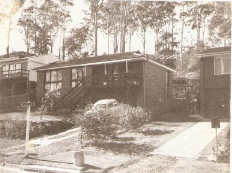
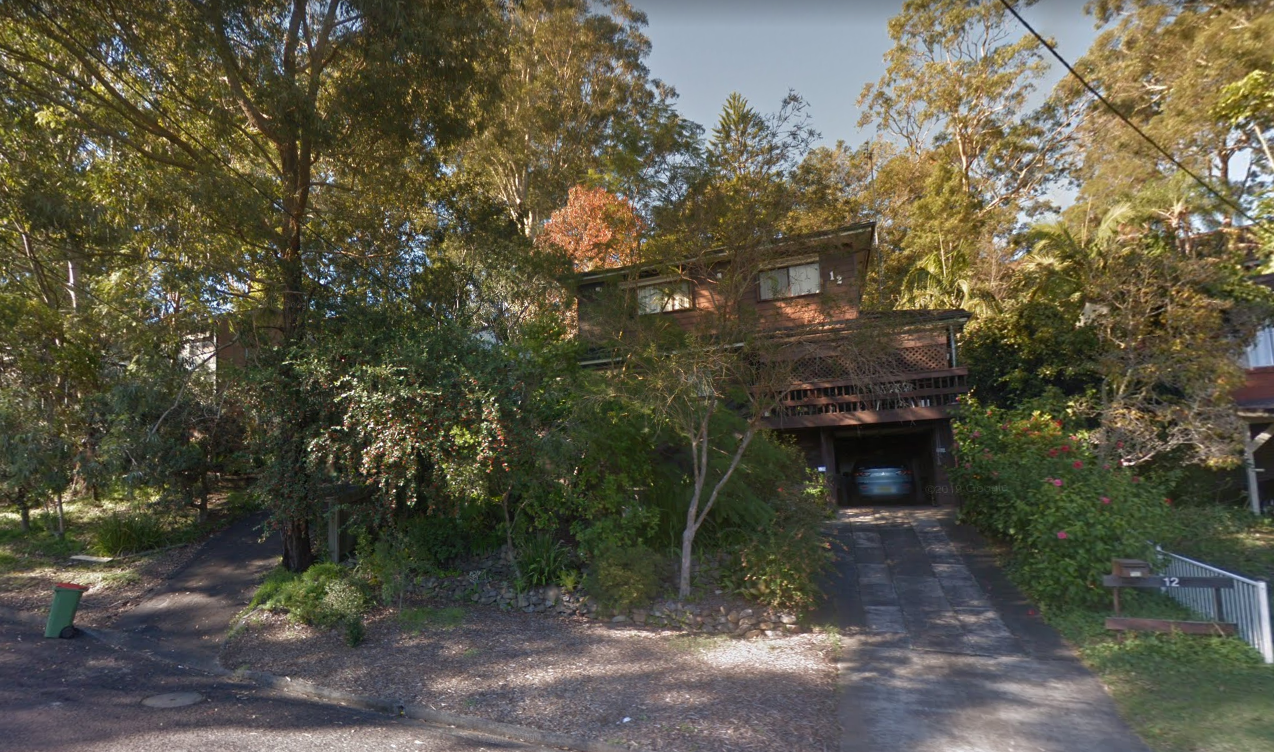
We had let house out to tenants this helped us with the payment of the loan on the house.
So we took early retirement I was only 53 years old and Elaine 49 years old when we moved to Narara.
I called on the Bishop of Newcastle he said he had nothing to offer me except half a parish up north of Newcastle.
At this time Ralph was tutoring at the Institute of Technology he had a friend who was an Industrial Electronics Teacher at Sydney TAFE who told Ralph that TAFE were looking for Industrial Electronic Teachers at Sydney TAFE and if I like I could apply for a position they would be Trade Testing soon.
I went for the Trade Test and passed it but they only required three teachers. The Tester told me that if I came in next Saturday they would test me again for an Electrical Trade Teacher, next Saturday came but there were three class room full of applicants I said to myself what a waste of time I haven’t got a hope in the world of beating these people.
To my surprise I was offered a teaching position they only needed twelve and I was number twelve.
I also found out if I had been one year older I would not have been accepted.
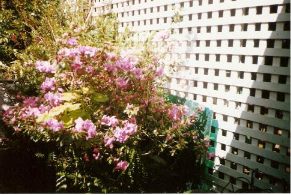
real home
Narara was the first and only real house that we owned and Elaine loved to work in her garden, and she made it a show piece both in the front and the back yard. One had to lookout if you made a mess in it when doing odd jobs around the place.
Inside the house she made it a home and until the cancer got the better of her it looked like a “new pin”.
Each room was furnished the way she wanted it, and the only room in the house which reflected me was my study, and even then I would be told that it was not tidy enough for her.
We fitted in well in the Parish of Wyoming.
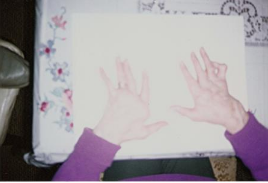
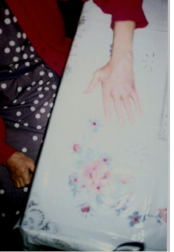
I became an Honorary Priest in the Parish and at that time there were three centres of worship, while Elaine got on the Organ Roster as usual and with more up to date treatment for Arthritis Elaine found her We fitted in well in the Parish of Wyoming I became an Honorary Priest in Parish and at that time there were three centres of worship, while Elaine got on the Organ Roster as usual and with more up to date treatment for Arthritis Elaine found her hands were a lot better.
Because Elaine’s hands had been badly affected by the arthritis she was sent to a specialist in Sydney to have joint replacement in the knuckles of her right hand. The operation was painful but it was the physiotherapy that was worse, the day after the operation the patients were expected to move their fingers and close their hand.
It was very painful exercise; one could not stand it for long. This happened daily and went on for about six weeks. Elaine travelled to St Leonards each day by train to see the physio.
Years later she had left hand operated on as well.
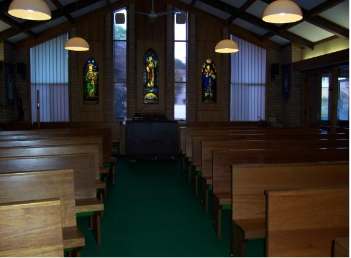
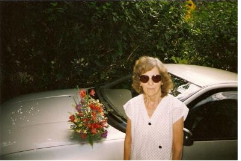

Elaine was diagnosed with colon cancer in 1990 it was the first of three cancer sessions. Elaine was “lucky” if you can call it lucky the tumour was found in a routine examination the doctor said this type is only discovered at your post mortem.
Radiotherapy followed but we were always worried that I would joke that not many husbands would get their wife a car for their forty second Wedding Anniversary. The truth of the matter was she paid for it herself.
Life went on but one could see that Elaine was not well. To top it off her eye sight was failing the cataracts in her eyes were getting worse so she had the cataracts removed.
In September 2009 she was found to have cancer number three and in October she had another operation where it was discovered that the cancer was in her liver and could not be removed.
We both know it was serious but we lived in hope that chemo could reduce the tumour.
But that was not to be, Elaine lost her long battle with
Cancer on February 18 2010 ten days after her birthday and two days before our 56
th wedding anniversary.
So I lost my beautiful little girl, the love of my life and I feel so lost and lonely.
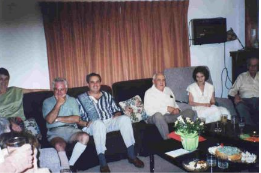
See also Reverend Bruce Holland tribute;